Nonjuring schism
The Non-juring schism was a split in the established churches of England, Scotland and Ireland, following the deposition and exile of James II & VII in the 1688 Glorious Revolution.
| Part of a series on |
| Anglicanism |
|---|
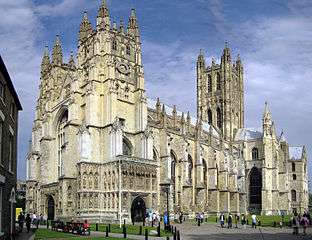 |
|
Ministry and worship |
|
|
|
Background and history |
|
|
As a condition of office, clergy were required to swear allegiance to the usurping monarchs; for various reasons, some refused to take the oath to his successors William III and Mary II. These became known as Non-juring, from the Latin verb iūrō, or jūrō, meaning "swear an oath".
For different reasons, around 339 Church of England priests refused to swear in 1689, some 2% of the total, although this did not mean they lost their positions. More serious for the government was the refusal of nine bishops to do so; despite efforts to reach a compromise, they were removed in 1691, by which time three of them had died.
In 1693, William Sancroft, former Archbishop of Canterbury appointed his own bishops, creating the schismatic Non Juror Church. The majority refused to follow him and remained within the Church of England, acting as an internal pressure group; these are sometimes referred to as 'Crypto-Non Jurors'. Never large in numbers, the Non Juror church rapidly declined after 1715, although minor congregations remained in existence until the 1770s.
In 1690, the Church of Scotland, or kirk, removed bishops and expelled Episcopalians, leading to a permanent divide. This was recognised in 1711, when the Scottish Episcopalians Act sanctioned the separate Scottish Episcopal Church. When George I became king in 1714, the church divided into a majority Non-Juror element, and those willing to swear allegiance to the Hanoverian regime. The split continued until the death of Charles Stuart in 1788.
The Non-Juring movement in Ireland was insignificant, although it produced Jacobite propagandist Charles Leslie. The Episcopal church in North America was then part of the Church of England, but largely unaffected until after the American Revolution when the Scottish non-juror liturgy influenced that of the new US Episcopal Church.
Origins
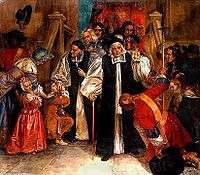
Today, Presbyterian or Episcopalian implies differences in both governance and doctrine but this was not the case in the 17th and 18th centuries. Episcopalian structures were governed by bishops, appointed by the monarch; Presbyterian implied rule by Elders, nominated by congregations. Arguments over governance were driven by politics, not only religious belief.[1]
In 1688, the three established churches were all nominally Episcopalian in structure, but followed different doctrines. The Church of England covered over 80% of the population and adopted a blend of Catholic and Protestant teachings. Around 75% of the Irish were Catholic, while the Church of Ireland was a minority even among Protestants, the majority being Nonconformist. Ninety-five percent of Scots were members of the Church of Scotland or kirk, which was predominantly Calvinist in doctrine.[2]
Although James became king in 1685 with widespread support in all three kingdoms, this changed when his policies seemed to move beyond tolerance for Catholicism and into an attack on the established church. The 1638 to 1652 Wars of the Three Kingdoms highlighted the dangers of religious division and moderates on both sides wanted to avoid a schism. Many supported James in 1685 from fear of civil war if he were bypassed; by 1688, it seemed only his deposition could prevent one.[3]
The prosecution of the Seven Bishops for seditious libel in June 1688 alienated High Church Tories, his main English support base. Many felt James violated his coronation oath, in which he swore to maintain the primacy of the Protestant religion. This made compliance with oaths and undertakings a key issue.[4]
English Non-Juring Movement
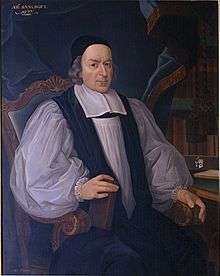
'Non-Juror' is the term used for those who refused to take the 1688 Oath of Allegiance to the new monarchs, William III and Mary II. It also covers Non-Abjurors, who refused the Oath of Abjuration in 1701 and 1714, requiring them to deny the Stuart claim.[5]
Nine bishops became Non Jurors, including William Sancroft, Archbishop of Canterbury, and five of the seven prosecuted in June 1688.[lower-alpha 1] One study estimates 339 members of the clergy became Non Jurors, around 2% of the total; of these, 80 subsequently agreed to comply, offset by 130 who refused the Oath of Abjuration in either 1701 or 1714. This ignores natural decline, so the actual number at any time would have been lower; many were concentrated in urban areas like London and Newcastle, which implies large parts of England were untouched by the controversy.[6]
Identifying lay members is more complex, since by definition it is restricted to those holding an office requiring the oath. One list identifies a total of 584 clergy, schoolmasters and university dons as Non Jurors, but this almost certainly understates their numbers.[7]
Reasons varied; some, like Bishop Ken, considered themselves bound by their oath to James, but continued to attend church services. Others argued the new regime was illegitimate, since divine right and inheritance meant kings could not be removed, the so-called 'state point'. A more fundamental issue was the 'church point', or belief Parliament had no right to intervene in ecclesiastical affairs, whether appointing or removing bishops and clergy, or changes to church policies.[8]
History
Regular clergy were largely left in peace; the Non Juring bishops were suspended in February 1690, but remained in place as William tried to negotiate a compromise. This failed, and in May 1691, Parliament appointed six new bishops, three of the original nine having since died.[9]
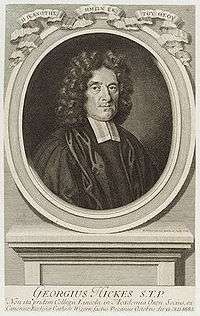
In May 1692, Sancroft delegated his powers to Bishop Lloyd, who in May 1693 appointed Thomas Wagstaffe (1645-1712) and George Hickes (1642-1715) as new Non-Juring bishops. Lloyd argued he simply wanted to establish the principle Parliament had no right to deprive or appoint bishops, but it created a formal schism; the vast majority remained within the established church, while Wagstaffe refused to exercise his powers.[10]
Key Non-Juror influencers, including Henry Dodwell (1641-1711), and Robert Nelson (1656–1715), returned to the main church in 1710. Hickes, whose hardline views on divine right and the primacy of Stuart authority led to his appointment as Charles II's chaplain in 1683, was the main driver behind the Non Juror church; it sharply declined after his death in 1715.[11]
In 1719, the church split into 'Usager' and 'Non-Usager' factions, both sides consecrating their own Bishops. Effectively, Non-Usagers wanted an eventual reconciliation with the main Church of England, while Usagers looked back to a 'primitive' church, including use of the long defunct 1549 Book of Common Prayer.[12] The Usagers began discussions with the Greek Orthodox Church on union, which went on from 1716 to 1725 before both sides admitted failure.[13] Despite Usagers and Non Usagers agreeing to re-unite in 1732, divisions continued.[14]
By the early 1740s, significant Non-Juring congregations were restricted to Newcastle, London and Manchester.[15] Robert Gordon, consecrated in 1741, was the last regular Non-Juring bishop, and led the group in London until his death in 1779. Usager Thomas Deacon headed that in Manchester, known as the Orthodox British Church (OBC); three of his sons and several other members joined the Manchester Regiment in the 1745 Rising. The OBC lasted until the first decade of the nineteenth century. The nonjuring congregations largely disappeared after the 1770s, although it has been suggested traces of its theology reappeared in the 1830s Oxford Movement.[16]
Numbers and Significance
Membership of the schismatic church was initially confined to clerics, then later broadened into the lay population. Largely restricted to urban areas, its congregations continually shifted, making it difficult to assess numbers; it is suggested these were negligible, certainly fewer than Catholics, who were around 1% of the population.[17]
A far larger group were 'crypto-Non Jurors', those who remained with the established church after 1693, but shared some Non Juror concerns; while many were sympathetic to the Stuarts, only a few were active Jacobites. Typical of this High Church, Tory group was Lady Elizabeth Hastings, daughter of the Earl of Huntingdon, a Stuart loyalist. Their support was based on the 'church point', and they opposed measures seen as diminishing the primacy of the Church of England. These included the 1689 Toleration Act, and 'occasional conformity', allowing Catholics and Nonconformists limited freedom of worship.[18]

As a result, Stuart Catholicism was an insuperable barrier to their restoration, although attempts were made to convert James and his successors; when Prince Charles visited London in 1750, he was inducted into the Non-Juring church, probably by Bishop Robert Gordon.[lower-alpha 2][19]
Despite their limited numbers, Non Juror clergy exercised significant influence over church policy. Many opposed post 1689 changes that moved the Church of England away from Laudian principles of authority, and allowed greater tolerance of different practices.[20] This led to demands for Convocation, or church assembly, to have a greater say over policy; it is suggested this was a contest between a largely Tory, High Church clerical body, and Whig bishops. Francis Atterbury, later associated with a 1722 Jacobite plot, was a prominent supporter of Convocation, although not a Non Juror himself.[21]
Outside politics, the Non Juror movement had an impact far greater than often appreciated, which continues today. Lady Elizabeth was part of a network of wealthy High Church philanthropists, linked by Non-Jurors like Robert Nelson, who supported measures intended to eliminate 'un-Christian behaviour', including the conversion of Catholics and Nonconformists. In 1698, this group established the Society for the Propagation of Christian Knowledge, or SPCK, followed in 1701 by the Society for the Propagation of the Gospel in Foreign Parts, or SPG, which are still in existence. Other members included Joseph Smith, renowned for converting English Catholics; in 1701, the SPG sent George Keith to New Jersey to do the same with Quakers.[22]
Some later became early advocates of Methodism, which began as a reform movement within the Church of England. One of these was Lady Hasting's daughter-in-law, Selina Hastings (1707–1791), founder of the evangelical Methodist sect known as the Countess of Huntingdon's Connexion.[23] Methodists were often accused of Jacobitism, because they rejected existing structures and practices; conversely, many "Jacobite" demonstrations during the 1730s were led by Tories hostile to the Welsh Methodist revival.[24]
Often associated with social conservatism, crypto Non-Jurors included Mary Astell (1666–1731), an educationalist sometimes called the first English feminist.[25] Daughter of a wealthy, upper-class Non-Juror merchant, in 1709, she set up a girls' school in Chelsea. Supported by the SPCK, Nelson, Dodwell, Lady Elizabeth and Lady Catherine Jones, it is thought to be the first in England with an all-women Board of Governors.[26] This shows the difficulty of making generalisations about the English Non Juror movement.
Irish Non-Juring Movement
The Church of Ireland was a minority, even among Irish Protestants, and during the 1689 Parliament called by James, four bishops sat in the Lords, with Anthony Dopping, Bishop of Meath acting as leader of the opposition.[27] Non Juror Henry Dodwell was born and educated in Ireland, but spent his career in England, making William Sheridan, Bishop of Kilmore and Ardagh the most significant Irish Non Juror. Son of a Catholic convert, he lost office as a result, and later died in poverty in London. Only a handful of Irish clergy followed his example, the most notable being Jacobite propagandist Charles Leslie.[28]
As in England, many sympathised with aspects of Non Juror policy; John Pooley, Bishop of Raphoe, avoided taking the Oath of Abjuration until 1710, while Bishop Palliser was a long time correspondent of Dodwell and Non Juror historian Thomas Smith. Bishop Lindsay, later Archbishop of Armagh, was a close friend of Jacobite plotter Francis Atterbury, and himself accused of Jacobitism in 1714. However, most of these links appear to have been driven by friendship, rather than political belief.[29]
Scottish Non Jurors and the Scottish Episcopal Church
.jpg)
English Non Juring was largely a split within Episcopalianism, but this was not the case in Scotland, where the religious conflicts of the 17th century normalised the eviction of defeated opponents. In 1688, Scots were divided roughly equally into Presbyterians and Episcopalians, the latter concentrated in the Highlands, Banffshire, Perthshire, Angus and Aberdeenshire. The 1690 General Assembly of the Church of Scotland abolished bishops and expelled 200 ministers who refused to accept these changes.[30]
As in England, many remained in place; Michael Fraser served as minister of Daviot and Dunlichty continuously from 1673 to 1726, despite being evicted in 1694 and joining both the 1715 and 1719 Risings.[31] Moderates within the kirk facilitated the readmission of deprived ministers; from 1690 to 1693, 70 of the 200 returned after taking the Oath of Allegiance, plus another 116 after the 1695 Act of Toleration. In 1702, a contemporary estimated 200 of 796 parishes were held by Episcopalian ministers, but the numbers above suggest many were not Non Jurors.[32]
Before 1690, differences were largely about governance, but as they dwindled in numbers, Scottish Episcopalians increasingly focused on doctrine. They saw the 1707 Union as an opportunity to regain power via a unified British church, and began using English liturgy to help this process.[33] The 1711 Scottish Episcopalians Act gave a legal basis for the Scottish Episcopal Church, while the 1712 Toleration Act provided legal protection for use of the Book of Common Prayer, whose rejection in 1637 sparked the Bishops' Wars.[34]
When George I succeeded Queen Anne in 1714, the church split into a majority Non-Juror element and Qualified Chapels, those willing to swear allegiance to the Hanoverian regime.[35] Non-Juring Episcopalianism became a mark of Jacobite commitment and a high percentage of both Lowlanders and Highlanders who participated in the 1745 Rising came from this element of Scottish society.[36]
Post 1745, many Non-Juror meeting houses were closed or destroyed, and further restrictions placed on their clergy and congregants. When Prince Charles died in 1788, he was succeeded by his brother Henry, a Catholic Cardinal, and the Episcopal Church now swore allegiance to George III, ending the schism with the Qualified Chapels. Some refused; the last Nonjuring clergyman died in 1808, while the Qualified Chapel in Montrose remained independent until 1920.[35] When the penal laws were finally lifted in 1792, the Church had fewer than 15,000 members, less than one percent of the Scottish population.[34] Today, the Scottish Episcopal Church is sometimes pejoratively referred to as the "English Kirk".[37][38]
Non Jurors in North America
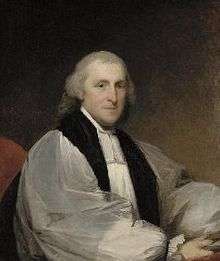
The political conflicts of the 1688 Glorious Revolution were reflected to a lesser degree in British North America and the Caribbean. The proximity of Catholic New France meant limited sympathy for James; in 1700, New York banned Catholic priests from the state. However, Virginia removed several Non Jurors from office in 1691.[39]
Richard Welton became a Non Juror in 1714, losing his parish in Whitechapel as a result; in 1724, he was ordained a bishop by Non-Usager Ralph Taylor, and moved to North America. He replaced John Urmiston as Rector of Christ Church, Philadelphia; Urmiston demanded he be reinstated, and the dispute drew in John Talbot, rector of St. Mary's Episcopal Church, Burlington, New Jersey since April 1704.[40]
Episcopalian ministers were in short supply in North America, one reason being delays caused by the need for London to approve appointments; between 1712 and 1720, Talbot presented numerous petitions requesting the appointment of a bishop.[41] On a visit to England in 1722, Taylor made him a Non Juror bishop, and when Pennsylvania Governor Sir William Keith informed the church authorities, Talbot and Welton were suspended. Talbot remained in North America, where he died in 1727; Welton returned to England in 1726, dying shortly afterwards in Portugal.[42]
Failure to establish a colonial episcopate was partly due to opposition by American Nonconformists; combined with the activities of the SPG, they viewed it as an attempt to impose a state church. In 1815, John Adams claimed a key element in mobilising popular support for the 1773 American Revolution was the "apprehension of Episcopacy”.[43]
After the outbreak of the Revolution, many Episcopal ministers remained loyal to the London government, and were removed. In Pennsylvania, most supported the Patriots, including William White, who set out principles establishing the American Episcopal Church. These were accepted by all the states, apart from Connecticut, which insisted each state must be controlled by its own bishop.[44]
Connecticut sent Loyalist Samuel Seabury to England to be made a bishop, but since he could not take the required Oath of Allegiance to George III, he was consecrated instead by the Scottish church in November 1784. Concerned at the prospect of another schism, Parliament agreed to waive the oath, and on 4 February 1787, White was consecrated Bishop of Pennsylvania by the Archbishop of Canterbury.[44]
Prominent Nonjurors
- Hilkiah Bedford (1663–1724), chaplain to Bishop Ken, author of Vindication of the Church of England (1710)
- Charles Booth (d. 1813), last Non-juring bishop
- William Bowyer the Younger (1699–1777), "the learned printer"
- Thomas Brett (1667–1743), of Spring Garden, liturgical scholar, nonjuring bishop
- Archibald Campbell (d. 1744), Scottish bishop, usager bishop, author of The Middle State
- Jeremy Collier (1650–1726), nonjuring primus, ecclesiastical historian, writer, and critic
- Thomas Deacon (1697–1753), stepson of Jeremy Collier, liturgical scholar, bishop of Manchester;
- Henry Dodwell (1641–1711), Anglo-Irish patristic scholar, Oxford don, author of The Case in View
- Elijah Fenton (1683–1730), poet
- Robert Forbes (1708–1775), Bishop of Ross and Caithness and historian of the Jacobite Rising of 1745
- Marmaduke Fothergill (1652–1731), Vicar of Skipwith and antiquarian
- Henry Gandy (1649–1734), bishop in non-usager succession
- Thomas Garnett (d. 1818), of Manchester, bishop in irregular usager line
- Robert Gordon (1703–1779), last bishop in the regular nonjuring succession. Also called Gordoun.
- Lady Elizabeth Hastings (1682-1739); philanthropist, early supporter of Methodism
- Charles Leslie (1650–1721), Jacobite propagandist, author of The Rehearsal and Short and Easy Method with the Deists
- Robert Nelson (1656-1715), founding member of the Society for the Propagation of Christian Knowledge;
- Samuel Pepys, Secretary to the Admiralty under Charles II and James II, diarist.
- Joseph Smith (1670-1756), Provost of The Queen's College, Oxford
- Thomas Smith (1638-1710), historian and librarian
- Richard Rawlinson (1690–1755) clergyman, book collector, antiquarian, and nonjuring bishop
- Ralph Taylor (divine) (1647-1722), nonjuring bishop in non-usager line
- John Urry (1666–1715), literary scholar, editor of Chaucer
- Thomas Wagstaffe the Elder (1645–1712), nonjuring bishop and vindicator of Charles I
- Thomas Wagstaffe the Younger (1692–1770), usager controversialist, later Anglican Chaplain at the Stuart court in Rome;
Notes
- Church of England bishops who became Non-Jurors; William Sancroft, Thomas Ken, John Lake, Francis Turner, Thomas White, Thomas Cartwright, Robert Frampton, William Lloyd and William Thomas
- He later returned to the Catholic church
References
- Main, David. "The Origins of the Scottish Episcopal Church". St Ninians Castle Douglas.
- McDonald 1998, pp. 75–76.
- Wormsley 2015, p. 189.
- Harris 2007, pp. 179–181.
- Ollard 1912, p. 412.
- Walsh 1993, p. 31.
- Overton 1902, pp. 467-496.
- Hastings 1917, p. 395.
- Overton 1902, p. 14.
- Mitchell 1937, p. 205.
- Cornwall, 2004 & DNB Online.
- Mitchell 1937, p. 207.
- Shukman 2006, pp. 175-191.
- Robb, 2013 & DNB Online.
- Yates 2017, p. 18.
- Mitchell 1937, p. 211.
- Szechi 2006, p. 54.
- Flaningam 1977, pp. 39–41.
- Robb 2013.
- Meza 1973, pp. 63-65.
- Meza 1973, p. 68.
- Duncan 1973, p. 239.
- Schlenther 2008.
- Monod 1993, pp. 197–199.
- Livingstone 1998, p. 87.
- Scott 1983, p. 100.
- Moody, Martin and Byrne 2009, p. 489.
- Higgins 2014, p. 78.
- Doyle 1997, pp. 32-34.
- Lynch 1992, p. 300.
- Lenman 1980, p. 56.
- Frace 2008, p. 361.
- Stephen 2013, p. 294.
- Dickinson 2006, p. 268.
- Bertie 2000, p. 649.
- Szechi, Sankey 2001, p. 97.
- Published on Friday 4 April 2008 15:08 (2008-04-04). "We're NOT English Kirk! - Local Headlines". Lanark Gazette. Retrieved 2012-08-13.
- Macleod, Murdo (16 July 2006). "Church fury over historic mistakes on 'English kirk'". The Scotsman. Edinburgh.
- Parrish 2013, p. 47.
- Duncan 1973, p. 241.
- Duncan 1973, pp. 250-252.
- Cornwall, 2004 & Oxford DNB Welton, Richard.
- Walker 2017, pp. 306-308.
- Mills, 2004 & Oxford DNB White, William.
Sources
- Cornwall, Robert D (2004). Wagstaffe, Thomas (1645 (Online ed.). Oxford DNB.CS1 maint: ref=harv (link)
- Cornwall, Richard (2004). "Welton, Richard (1671/1672-1726)". Oxford Dictionary of National Biography (Online ed.). Oxford University Press. doi:10.1093/ref:odnb/29031.CS1 maint: ref=harv (link) (Subscription or UK public library membership required.)
- Doyle, Thomas (1997). "Jacobitism, Catholicism and the Irish Protestant Elite, 1700-1710". Eighteenth-Century Ireland / Iris an Dá Chultúr. 12: 28–59. JSTOR 30071383.CS1 maint: ref=harv (link)
- Duncan, Robert William (1973). "A Study of the Ministry of John Talbot in New Jersey, 1702-1727: On 'Great Ripeness' Much Dedication, and Regrettable Failure". Historical Magazine of the Protestant Episcopal Church. 42 (3): 233–256. JSTOR 42973381.CS1 maint: ref=harv (link)
- Dickinson, HT (ed) (2006). Eighteenth Century Britain (Blackwell Companions to British History). John Wiley & Sons. ISBN 1405149639.CS1 maint: extra text: authors list (link) CS1 maint: ref=harv (link)
- Flaningam, John (1977). "The Occasional Conformity Controversy: Ideology and Party Politics, 1697-1711". Journal of British Studies. 17 (1): 38–62. doi:10.1086/385711.
- Frace, Ryan K (2008). "Religious Toleration in the Wake of Revolution: Scotland on the Eve of Enlightenment (1688–1710s)". History. 93 (3): 355–375. doi:10.1111/j.1468-229X.2008.00429.x. JSTOR 24428394.CS1 maint: ref=harv (link)
- Harris, Tim (2007). Revolution; the Great Crisis of the British Monarchy 1685-1720. Penguin. ISBN 978-0141016528.CS1 maint: ref=harv (link)
- Hastings, James (1917). Encyclopedia of Religion and Ethics; Volume IX. T & T Clark.CS1 maint: ref=harv (link)
- Higgins, Ian (author), MacInnes, Alan (ed), Graham, Lesley (ed), German, Kieran (ed) (2014). Jonathan Swift's Memoirs of a Jacobite in Living with Jacobitism, 1690–1788: The Three Kingdoms and Beyond. Routledge. ISBN 978-1848934702.CS1 maint: extra text: authors list (link) CS1 maint: ref=harv (link)
- Lenman, Bruce (1980). The Jacobite Risings in Britain 1689–1746. Methuen Publishing. ISBN 978-0413396501.CS1 maint: ref=harv (link)
- Lynch, Michael (1992). Scotland: A New History (2011 ed.). Pimlico. ISBN 0712698930.CS1 maint: ref=harv (link)
- Mackie, JD (author) Lenman, Bruce (author), Parker, Geoffrey (editor) (1986). A History of Scotland. Hippocrene Books. ISBN 978-0880290401.CS1 maint: multiple names: authors list (link) CS1 maint: extra text: authors list (link) CS1 maint: ref=harv (link)
- MacInnes, Alan (ed), Graham, Lesley (ed), German, Kieran (ed), Higgins, Ian (2014). Jonathan Swift's Memoirs of a Jacobite in Living with Jacobitism, 1690–1788: The Three Kingdoms and Beyond. Routledge. ISBN 978-1848934702.CS1 maint: multiple names: authors list (link) CS1 maint: extra text: authors list (link) CS1 maint: ref=harv (link)
- Meza, Pedro Thomas (1973). "The Question of Authority in the Church of England, 1689 to 1717". Historical Magazine of the Protestant Episcopal Church. 42 (1): 63–86. JSTOR 42973369.CS1 maint: ref=harv (link)
- Mills, Frederick V (2004). "White, William". Oxford Dictionary of National Biography (Online ed.). Oxford University Press. doi:10.1093/ref:odnb/74335.CS1 maint: ref=harv (link) (Subscription or UK public library membership required.)
- Mitchell, Albert (1937). "The Non-Jurors; 1688-1805". The Churchman. 51 (2).CS1 maint: ref=harv (link)
- Monod, Paul Kleber (1993). Jacobitism and the English People, 1688–1788. Cambridge University Press. ISBN 978-0521447935.CS1 maint: ref=harv (link)
- Moody; Martin; Byrne (eds.) (2009). A New History of Ireland: Volume III: Early Modern Ireland 1534-1691. OUP. ISBN 9780198202424.CS1 maint: extra text: authors list (link) CS1 maint: ref=harv (link)
- Ollard, SL (1912). A Dictionary of English Church History. Mowbray & Co.CS1 maint: ref=harv (link)
- Parrish, David (2013). Jacobitism and the British Atlantic world in the age of Anne (PhD). PHD Thesis Glasgow University.CS1 maint: ref=harv (link)
- Pittock, Murray (1998). Jacobitism. Palgrave Macmillan. ISBN 978-0333667989.CS1 maint: ref=harv (link)
- Robb, Steven (2013). Gordon, Robert (1703-1779). Oxford DNB.CS1 maint: ref=harv (link)
- Schlenther, Boyd Stanley (2008). "Hastings [née Shirley], Selina, countess of Huntingdon (1707-1791)". Oxford Dictionary of National Biography (Online ed.). Oxford University Press. doi:10.1093/ref:odnb/12582.CS1 maint: ref=harv (link) (Subscription or UK public library membership required.)
- Scott, Beatrice (1983). "Lady Elizabeth Hastings". The Yorkshire Archaeological Journal. 55.CS1 maint: ref=harv (link)
- Shukman, Ann (2006). "The Non-Jurors, Peter the Great, and the Eastern Patriarchs". Anglicanism and Orthodoxy: 300 Years after the Greek College in Oxford. Oxford: Peter Lang.CS1 maint: ref=harv (link)
- Simms, J.G (1970). "The Bishops' Banishment Act of 1697 (9 Will. III, C. 1)". Irish Historical Studies. 17 (66): 185–199. doi:10.1017/S0021121400111381.CS1 maint: ref=harv (link)
- Stephen, Jeffrey (2013). Defending the Revolution: The Church of Scotland 1689–1716. Ashgate. ISBN 978-1409401346.CS1 maint: ref=harv (link)
- Bertie (editor), David M (2000). Scottish Episcopal Clergy 1689-2000. T & T Clark. ISBN 978-0567087461.CS1 maint: extra text: authors list (link) CS1 maint: ref=harv (link)
- Szechi, Daniel, Sankey, Margaret (November 2001). "Elite Culture and the Decline of Scottish Jacobitism 1716-1745". Past & Present. 173.CS1 maint: ref=harv (link)
- Szechi, Daniel (2006). 1715: The Great Jacobite Rebellion. Yale University Press. ISBN 978-0300111002.CS1 maint: ref=harv (link)
- Walker, Peter (2017). "The Bishop Controversy, the Imperial Crisis, and Religious Radicalism in New England, 1763-74". New England Quarterly. XC (3).CS1 maint: ref=harv (link)
- Walsh, John (author), Hayton, Colin (ed) (1993). Introduction in The Church of England C.1689-c.1833: From Toleration to Tractarianism. Cambridge University Press. ISBN 978-0521417327.CS1 maint: extra text: authors list (link) CS1 maint: ref=harv (link)
- Wormsley, David (2015). James II: The Last Catholic King. Allen Lane. ISBN 978-0141977065.CS1 maint: ref=harv (link)
- Yates, Nigel (2017). Eighteenth-century Britain: Religion and Politics, 1715-1815. Routledge. ISBN 978-1138154346.CS1 maint: ref=harv (link)
External links
- Main, David. "The Origins of the Scottish Episcopal Church". St Ninians Castle Douglas.